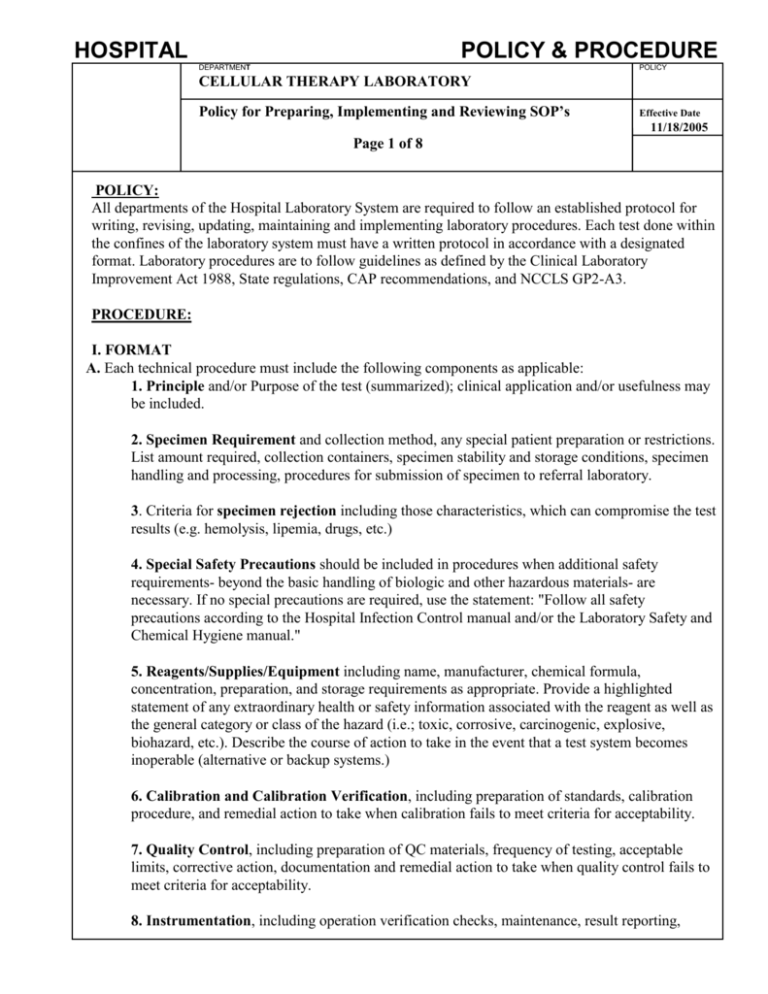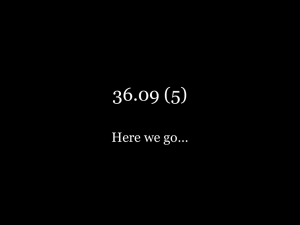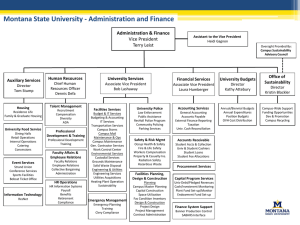Document Control 5
advertisement

HOSPITAL POLICY & PROCEDURE DEPARTMENT POLICY CELLULAR THERAPY LABORATORY Policy for Preparing, Implementing and Reviewing SOP’s Effective Date 11/18/2005 Page 1 of 8 POLICY: All departments of the Hospital Laboratory System are required to follow an established protocol for writing, revising, updating, maintaining and implementing laboratory procedures. Each test done within the confines of the laboratory system must have a written protocol in accordance with a designated format. Laboratory procedures are to follow guidelines as defined by the Clinical Laboratory Improvement Act 1988, State regulations, CAP recommendations, and NCCLS GP2-A3. PROCEDURE: I. FORMAT A. Each technical procedure must include the following components as applicable: 1. Principle and/or Purpose of the test (summarized); clinical application and/or usefulness may be included. 2. Specimen Requirement and collection method, any special patient preparation or restrictions. List amount required, collection containers, specimen stability and storage conditions, specimen handling and processing, procedures for submission of specimen to referral laboratory. 3. Criteria for specimen rejection including those characteristics, which can compromise the test results (e.g. hemolysis, lipemia, drugs, etc.) 4. Special Safety Precautions should be included in procedures when additional safety requirements- beyond the basic handling of biologic and other hazardous materials- are necessary. If no special precautions are required, use the statement: "Follow all safety precautions according to the Hospital Infection Control manual and/or the Laboratory Safety and Chemical Hygiene manual." 5. Reagents/Supplies/Equipment including name, manufacturer, chemical formula, concentration, preparation, and storage requirements as appropriate. Provide a highlighted statement of any extraordinary health or safety information associated with the reagent as well as the general category or class of the hazard (i.e.; toxic, corrosive, carcinogenic, explosive, biohazard, etc.). Describe the course of action to take in the event that a test system becomes inoperable (alternative or backup systems.) 6. Calibration and Calibration Verification, including preparation of standards, calibration procedure, and remedial action to take when calibration fails to meet criteria for acceptability. 7. Quality Control, including preparation of QC materials, frequency of testing, acceptable limits, corrective action, documentation and remedial action to take when quality control fails to meet criteria for acceptability. 8. Instrumentation, including operation verification checks, maintenance, result reporting, HOSPITAL POLICY & PROCEDURE DEPARTMENT POLICY CELLULAR THERAPY LABORATORY Policy for Preparing, Implementing and Reviewing SOP’s Effective Date 11/18/2005 Page 2 of 8 trouble-shooting and corrective actions. 9. Procedure including step-by-step directions, trouble-shooting and corrective actions. 10. Microscopic Examinations, including the detection of inadequately prepared slides. 11. Calculations (give an example) 12. Normal Range or Expected values (include age and sex specifics if available) 13. Critical values (if applicable) 14. Linearity or Reportable Range (if applicable) 15. Reporting Results (computer steps, prompts, etc.) 16. Interpretation of results 17. Procedure Notes 18. Limitations of methods including interfering substances, pitfalls, and precautions. 19. References including manufacturer's literature, textbooks (try to use reference less than 5 years old if available), standards publications (NCCLS). 20. Author ("Prepared by ____________" statement) 21. Approval, including committees and responsible managers. 22. Original Date (date original policy was put into effect) 23. Replacement date (list every replacement in chronological order) 24. Review signatures 25. For Intranet policies, include statement: "Original Policy Signed by: (titles)" 26. Take draft copy to system-wide team meetings for review and changes. Policies and procedures should be written with a system perspective when possible. 27. Make corrections according to comments on all review documents. HOSPITAL POLICY & PROCEDURE DEPARTMENT POLICY CELLULAR THERAPY LABORATORY Policy for Preparing, Implementing and Reviewing SOP’s Effective Date 11/18/2005 Page 3 of 8 28. Continue steps 2-4 as necessary. 29. Revisions should be reviewed and approved by the Medical Director, Laboratory Director and Laboratory Supervisor. 30. Obtain required approval signatures. 31. Assign Effective Date after all signatures are obtained and staff education has occurred. B. Each non-technical procedure may include: 1. Any of the above technical components as necessary. 2. Any policy statements pertaining to the operation of individual departments. C. Effective Date: The Effective Date of the policy should be after the last signature date. II. INDEX A. The Laboratory follows Hospital guidelines in the numbering of policies and procedures. The following numbers are to be used by each department: 105.000 – 105. Assessment of the Patient – Laboratory 180.000 – 180. Lab Administration 180.500 – 180. Laboratory Information Systems 181.000 – 181. Lab Safety/Chemical Hygiene 182.000 – 182. Medical Technology Program 182.400 – 182. Lab Continuing Education 182.700 – 182. Blood Collection Program 182.851 – 182. Cytology Prep Tech Program 183.001 – 183. Phlebotomy / Specimen Collection 183.250 – 183. Specimen Receiving / Processing 183.500 – 183. Courier Services 183.750 – 183. Client Services 184.000 – 184. Chemistry 185.000 – 185. Microbiology 186.000 – 186. Virology 186.400 – 186. Serology 186.700 – 188. Parasitology 187.000 – 187. Hematology 187.500 – 188. Coagulation 188.000 – 188. Flow Cytometry 188.500 – 188. Urinalysis 189.000 – 189. Blood Bank HOSPITAL POLICY & PROCEDURE DEPARTMENT POLICY CELLULAR THERAPY LABORATORY Policy for Preparing, Implementing and Reviewing SOP’s Effective Date 11/18/2005 Page 4 of 8 190.000 – 190. Histology/Pathology 191.000 – 191. Tissue Typing 192.000 – 192. Cytology 193.000 – 193. Hospital Cancer Institute – Hemostasis/Thrombosis 193.500 – 193. Hospital Cancer Institute – Molecular Diagnostics 194.000 – 194.999 Surgical Lab B. Index Composition 1. All policy and procedure manuals will have an alphabetical and numerical index. The index should list the policy number, the title, and the effective date of the most current copy of the policy. The “Level” is listed as (1) for hospital wide policies that affect all departments, (2) for policies that affect two or more departments, or (3) for department specific policies only. 2. A Master Index will be maintained for EACH manual. The master index will contain policies from ALL campuses and a standardized, organized method of numbering/naming policies will be maintained. C. Title Key 1. Global Policy A Global Policy is a policy used by ALL campuses. This is a standardized Laboratory procedure/policy that is implemented without modifications at the campuses. It has NO specific notation or campus designation after the title. 2. If a policy is modified at a campus, add the campus name to the end of the title to indicate specific procedural instructions exist for that location. For example: 189 "Blood Bank Equipment Maintenance" becomes 189 "Blood Bank Equipment Maintenance – Al" for the modified policy at Al campus. III. WRITING OF PROCEDURES A. The following people are permitted to write procedures: 1. Supervisors 2. Assistant Supervisors/Instructors 3. Coordinators 4. Senior Technologists 5. Technologists 6. Directors 7. Assistant Directors 8. Administrative Coordinators 9. Pathologists HOSPITAL POLICY & PROCEDURE DEPARTMENT POLICY CELLULAR THERAPY LABORATORY Policy for Preparing, Implementing and Reviewing SOP’s Effective Date 11/18/2005 Page 5 of 8 B. The following process should be followed when writing a technical or administrative policy. 1. Write draft of policy, consulting with current and appropriate textbooks, journal articles, package inserts, department pathologist and other medical staff as needed. 2. Send draft copy to appropriate people for review and comment. These may include: a) Pathologist b) Lab Medical Director c) Lab Administrative Director d) Lab Assistant Administrative Director e) Lab Administrative Coordinators f) Administrative personnel of other affected departments such as Nursing, Safety, or Security. g) Supervisors and campus department coordinators IV. APPROVAL OF POLICIES A. Committee approval dates should be listed on the signature page (which should be documented in committee meeting minutes). B. Procedures are to be approved by the appropriate persons and their signature and date will indicate approval. This may include the following: 1. Department Supervisor 2. Administrative Coordinator 3. Administrative Director 4. Medical Director 5. Department Pathologist 6. Campus Lab Administrator and Campus Medical Director 7. Vice President over Laboratory 8. Administrative personnel of other affected departments C. Global policies are used throughout the laboratory system in an effort to standardize procedures. Signatures and approval for global policies include: 1. The Laboratory Administrative Director 2. The Laboratory Medical Director: the medical directors at individual campus laboratories have designated a pathologist to sign and review department and global policies and procedures. 3. Department Supervisors have been designated to perform the annual review of all department policies and procedures. 4. The system Department Teams (i.e.: Blood Bank Team, Hematology Team, etc.) will review and approve all procedural changes as needed. HOSPITAL POLICY & PROCEDURE DEPARTMENT POLICY CELLULAR THERAPY LABORATORY Policy for Preparing, Implementing and Reviewing SOP’s Effective Date 11/18/2005 Page 6 of 8 D. Campus Specific Policies are used at an individual satellite laboratory when unique instructions must be utilized at only that location. Signatures and approval for campus specific policies include: 1. The Campus Laboratory Administrative Director 2. The Campus Lab Medical Director 3. Campus Department Coordinator has been designated to perform the annual review of all department policies and procedures at each campus. E. Upon change of directorship, the new medical director must ensure that all lab procedures are well documented, reviewed promptly and undergo at least annual review by the supervisor, department pathologist, and/or medical director. V. DISTRIBUTION OF POLICIES AND PROCEDURES A. Copies of policies will be distributed to appropriate departments and campus laboratories. 1. Retain original policy in originating department 2. Intranet Policies: When the policy is available on the intranet, send an email to all affected department supervisors and campus directors (and others as necessary) to notify them of the policy's availability/update/etc. so that it can be reprinted for their manual. It can also be copied from the intranet if modifications are needed at the campus, and subsequently published on the intranet as a campus specific policy. 3. Non-intranet Policies a) Include a cover page listing policy additions/deletions/changes, date of distribution. b) Provide a new dated index (see II. Index above) which includes Effective Dates of policies c) Send a hard copy of the signed global policy plus a computer copy (on disk or via email) for campus modifications if necessary. VI. POLICY REVIEW A. Each procedure must be reviewed annually. Each reviewer should look for changes in methodologies, instrumentation, reagents, etc. The reviewer will determine the status of the procedure relevant to approval revision or deletion. B. The Laboratory Medical Director delegates the department technical supervisor, assigned senior technologist, and/or pathologist to review each policy and procedure. C. Signature and date document each procedure reviewed. D. Standardized Global policies: each individual policy will be reviewed at the location where the original manual is maintained. E. A logbook shall be maintained in each department that includes Policy and Procedure Changes. HOSPITAL POLICY & PROCEDURE DEPARTMENT POLICY CELLULAR THERAPY LABORATORY Policy for Preparing, Implementing and Reviewing SOP’s Effective Date 11/18/2005 Page 7 of 8 Documentation of employee review of new or changed policies is filed in this book. This documentation should be saved for three years. All department employees must sign/initial the document to indicate his/her acknowledgement and understanding of the procedural change. F. Personnel Review of Manuals: Laboratory manuals are to be reviewed by all laboratory personnel annually. VII. POLICY REVISION A. All changes to existing procedures must be approved by the department supervisor, pathologist, the laboratory administrative director, and/or the laboratory medical director. 1. Minor changes may be added to the original document and all campus copies. The supervisor must initial and date all changes. a) Draw a single line through the item to be changed b) Insert the change above the single line. c) Supervisor initials and dates after the inserted change d) Inform all testing personnel of change immediately e) Revisions are incorporated into a new updated policy within 2 years. 2. Major changes require retyping and reprinting the entire procedure and distributing the revised edition. If the change involves a major revision of the written procedure, or the introduction of a new test, procedure, or instrument, a technical demonstration of the new test must be presented to employees. Employees shall be educated about new or modified policies or procedures with the appropriate training and/or competency validated before performing new testing. 3. Employees shall be notified of policy changes, new policies, and removal of policies promptly. Notification and education shall target employees where appropriate. Documentation of employee review of the new procedure should be maintained in the Policy and Procedure Change logbook. VIII. MANUAL LOCATION 1. Policies and procedures must be accessible to employees within the department, at or near the area where the test is to be performed. 2. Shortened, step-by-step procedures describing the actual performance of the test may be written on index cards and kept at the location of the testing to be done; however, this does not constitute nor replace a complete procedure. IX. DISCONTINUED POLICIES Obsolete or superseded policies are removed to a retired file for historical review and liability reasons. Such a retired record file must be kept indefinitely according to Hospital policy. HOSPITAL POLICY & PROCEDURE DEPARTMENT POLICY CELLULAR THERAPY LABORATORY Policy for Preparing, Implementing and Reviewing SOP’s Effective Date 11/18/2005 Page 8 of 8 REFERENCES: Clinical Laboratory Improvement Act, 1988 College of American Pathologists, Laboratory Accreditation Program, 2001 Checklist Joint Commission on Accreditation of Healthcare Organizations, Accreditation Manual for Pathology and Clinical Laboratory Services, 2003 National Committee for Clinical Laboratory Standards, Document GP2-A4, "Clinical Laboratory Technical Procedure Manuals-Fourth Edition; Approved Guideline", April 2002. State Administrative Code, Chapter 59A-7 Prepared by: Date of Approval: _________ Date of Discontinuance: ____/____/____ Original Date: 10/1/1996 Replaces: July 2004 (193.416) Replaces: Oct. 15, 2004 __________________________ Medical Director ___________________________ Assistant Director







